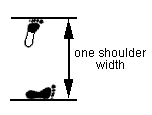Taekwondo stances
The Korean martial art Taekwondo has several stances used for different activities. Taekwondo has a wide variety of stances in its repertoire. These stances are most commonly seen in the form competition of Hyeong, and are critical for balance, precision, and good technique in the martial art.
Basic stances
There are two major organizations of Taekwondo: the World Taekwondo Federation and the International Taekwondo Federation. These two schools, while similar, show variance in their teachings of some of the stances. Individual schools within these larger umbrellas will also vary slightly in their teachings, but not to the large extent seen between WTF and ITF taekwondo.
| Diagram | Name | Description |
|---|---|---|
| |
Attention stance
Also known as:
|
In this stance, the legs are straight and touching each other, with toes pointing forward. The arms are straight and held stiffly at one’s side. In ITF style Taekwondo, the feet are put at a 45 degree angle as opposed to straight in WTF style. This is the stance that all bows come from. |
| |
Closed Stance[2]
Also known as:
|
Found in ITF taekwondo. This is mostly seen as a ready stance at the beginning and end of patterns, but can also be seen less frequently during pattern execution. Feet are placed together, and weight is distributed evenly between them. |
 |
Front stance
Also known as:
|
In this stance, the legs are held one in front and to the side of the other, in a wide and deep pose with hips facing forward. The front leg is bent and the other is straightened. This is a very firm and steady stance, one of the first learned by beginners, and is often used in poomsae / tul.
There is a variant of this stance called Nachuo Seogi or Low Stance which is One foot length longer. The stance can be either Full, Half or Reverse half facing. This variant is found in ITF taekwondo. |
 |
Back stance
Also known as:
|
In this stance, one foot is in front of the other, with the back foot pointed 90 degrees perpendicular, and the front foot pointed straight. The majority of the body weight is placed on the back leg.
There is a variant of this stance called Gojung Seogi or Fixed Stance which is One foot length longer, the weight distribution is 50-50, So when performing this stance one should just be able to see the toes of one's back foot over the knee. This variation is found in ITF taekwondo. All techniques in L-Stance can only be half facing. |
 |
Ready stance
Also known as:
|
In this stance, the legs are straight, with toes pointing straight forward, feet shoulder width apart. The arms are held in front of the body, with closed fists and elbows slightly bent, hands about six inches away from the navel. This is the position that all poomsae forms start from, and return to. Not all ITF tul start and finish in this stance, but it is still used as a ready stance in the Chang Hon pattern set. |
 |
Rear foot stance
Also known as:
|
In this stance, the legs are held bent and close together, with the back foot perpendicular to the body and the front foot straight and en pointe. This stance is found in the higher level forms. |
 |
Sitting stance
Also known as:
|
In this stance, the legs are in a squat position, with feet far apart facing forward and knees bent. This stance can also be used as a stretch. The object is typically to keep the back straight while lowering the buttocks down to the ground with the legs spread keeping shins perpendicular to the floor. |
Different stances
Fighting stance
This stance varies with the martial art and practitioner, but is the basic all-purpose stance used in sparring and combat. Common features across the arts include turning the body to the side to present a smaller target, slightly bent knees for balance and agility, feet about two shoulder widths apart, and hands up, protecting the head. In an art relying heavily on kicks, the body's mass is usually shifted slightly to the back leg, making the front leg easier to lift and increasing the speed of kicks. Regardless of the exact stance, this is the most familiar stance for a martial artist. All other stances, blocks, and attacks flow from this stance.
Diagonal stance
Sasun Seogi. Found in ITF taekwondo. This stance is very similar to the sitting stance, however one foot will be slightly more forward than the other.
Crouched stance
Oguryo Seogi. Found in ITF taekwondo. In this stance, the feet are spread wide apart, one foot slightly in front of the other. The knees are bent inward.
See also
References
- 1 2 "Korean Taekwondo Glossary (Translations)". Olympictaekwondo.org. Retrieved 17 February 2015.
- ↑ Archived September 5, 2012, at the Wayback Machine.